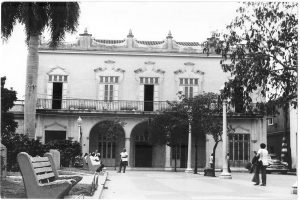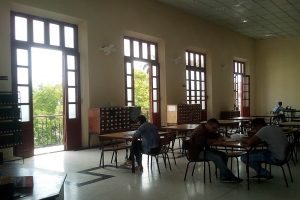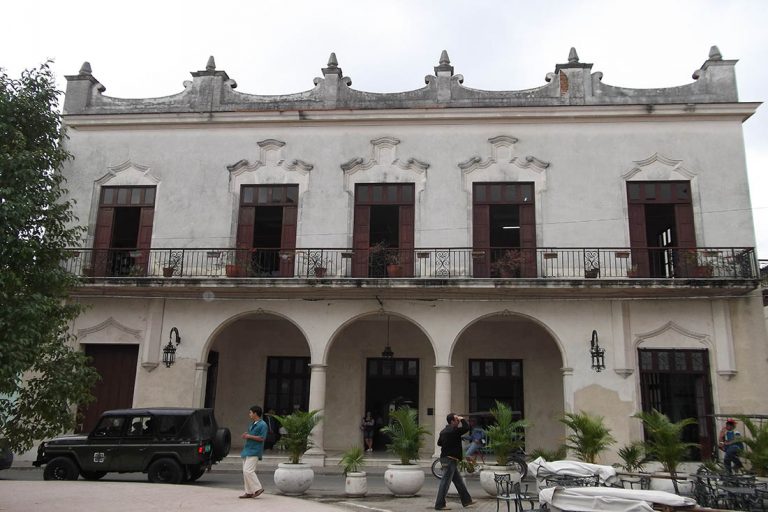The cultural policy drawn up by the Cuban government after the revolutionary triumph sought to ensure and raise the cultural level of the people. To do this, it created in the country a network of bookstores, libraries, museums, theaters, houses of culture, galleries, and art schools.
Specifically, the creation of a public library system would contribute to the accessibility of knowledge to all layers of the population in a wide spectrum; in addition to strengthening literature and promoting the study of all sciences and art; which in the long term would make it possible to fully deploy the capabilities of individuals. For this reason, in 1961, the National Council of Culture created the National Network of Public Libraries; while the José Martí National Library would be in charge of directing the founding process in each province.
The “Julio Antonio Mella” Provincial Library of Camagüey
 Immersed in this scenario, the Julio Antonio Mella Provincial Library of Camagüey was inaugurated on June 1st, 1963. The place chosen for its location, at the proposal of Commander Ernesto “Che” Guevara, would be the former headquarters of the Philharmonic Society later El Liceo de Puerto Principe, a bourgeois institution; for which it should become a social good and at that time the place where the Provincial Directorate of Culture was located . His name was established by mutual agreement of all those related to his foundation, since he was a figure closely linked to student life, to the world of political, social, cultural ideas, and to Camagüey.
Immersed in this scenario, the Julio Antonio Mella Provincial Library of Camagüey was inaugurated on June 1st, 1963. The place chosen for its location, at the proposal of Commander Ernesto “Che” Guevara, would be the former headquarters of the Philharmonic Society later El Liceo de Puerto Principe, a bourgeois institution; for which it should become a social good and at that time the place where the Provincial Directorate of Culture was located . His name was established by mutual agreement of all those related to his foundation, since he was a figure closely linked to student life, to the world of political, social, cultural ideas, and to Camagüey.
In the beginning it had a collection of about 18,000 volumes and about 200 records, distributed in the departments of Art, Music, Youth, Newspaper Library, Rare Funds and Reading Room. In 1970 the departments of Technical Processes, Literature Room and Technical Room were created.
The institution grew gradually, as different types of services were needed; although some rooms were eliminated according to contingencies such as: the Minerva Room, due to the obsolescence of its funds, which at a certain time provided valuable services to users; and a specialized book room, which was created due to the establishment of the Universalization of education, and was dissolved as careers were eliminated from this system. On the other hand, the Arts Hall merged with Music and an Exhibition Hall called The New Muse was inaugurated in which the plastic artists of the province can exhibit their works.
Since its foundation, directors such as: Magdalena de Varona, Isabel Serrano with Gladys Anarela, Senen Paz, Rafael Herrera, Osnaldo Fernández Gómez, Celia Zoa Rivero Pozas, Juan Merodio Pérez, Gelsy de la Cruz Cerezo, María Regla Bustillo (provisional), Elgida Gil Álvarez, during her mission in Mozambique, Elgida Gil Álvarez assumed companion Nelly, Ernestina (provisional), Wualquiria (provisional), Elda Cento Gómez, Mirtha Padrón Torrens, Odalys Sánchez Cañete and Carmen Diego Fonseca (current director).
 Nowadays, it has 8 departments: Management, User Control, Administration, Specialists, Information Technology, Technical Processes, Conservation and Digitization and Library Extension; It also has a special area for people with disabilities and 6 reading rooms: Arts, with its concert hall, Youth and children, Newspaper Library, Literature, General and Rare and Valuable Funds. It also has a gallery that pays tribute to the services of the previous ones.
Nowadays, it has 8 departments: Management, User Control, Administration, Specialists, Information Technology, Technical Processes, Conservation and Digitization and Library Extension; It also has a special area for people with disabilities and 6 reading rooms: Arts, with its concert hall, Youth and children, Newspaper Library, Literature, General and Rare and Valuable Funds. It also has a gallery that pays tribute to the services of the previous ones.
Each one has their names and develops activities in accordance with the gender, group to which they are directed. In a general sense, they all have rich and valuable collections that facilitate the search for any information and knowledge.
Business purpose, mission and vision
The business purpose of this institution is: to provide a service of higher quality and excellence, proposing educational, cultural and political objectives that constitute the primary and elementary basis of the culture spread process that is strategically developed throughout the country, adapting the interests of the institution to the particularities of the community and territory; as well as to treasure and preserve the historical memory of the province in correspondence with the norms and regulations of our socialist state.
Its mission is: “To preserve, protect and disseminate the bibliographic heritage and promote reading”, it is made up of nine reading rooms. Among them is the Rare and Valuable Collection Room, whose business purpose is to treasure the oldest printed materials or those that, due to their value or bibliographic rarity, deserve special attention.
It also has the vision of achieving high development in the application of new technologies to library management to improve the quality of information services, document processing, library and socio-cultural research, as well as conservation and protection of documents of high patrimonial value.
The library offers a group of services to the public such as: internal, external and interlibrary loan; loan of serials and special materials; inquiries and referrals by phone and email; compilations of bibliographies; and review of bibliographies of coursework and diploma; activities to promote reading in the community and the Library; workshops to promote reading in the Children’s and Youth Rooms; creation of mini-libraries and other forms of library extension in work centers, schools, health centers and prisons; bibliographic and plastic arts exhibitions; activities to promote reading with the elderly, people with disabilities and in health centers and prisons; musical auditions and concert music; Contests: Leer a Martí, I present my book, My library’s birthday, Many years ago, among others; guided visits with students of different levels of education; requests for information via email to the National Library; review of bibliographies to students of different levels; training for students of the Librarianship career; advice on research work; Internet search service; Encarta search service; Master’s Thesis Tutorials; Juries of events; Preparation of research endorsement; inquiries to completed investigations.
Hold a series of events such as: Camagüey’s Writers Meeting; Braille reading and writing encounter; Contest I present my book; Conference for the Anniversary of the founding of the Library and Librarian’s Day; ASCUBI Scientific Library Science Workshop; Meeting of Special Areas; My library’s birthday contest; Let’s honor our heroes contest; Oral Narration for Children and Young People meeting.
Throughout all these years it has been visited by prominent figures of our culture, among which are: Rosita Fornés, Onelio Jorge Cardoso, Nicolás Guillén, Leo Brouwer, José Antonio Portuondo, among others.
Present
At this time it is immersed in the celebration of the 58th anniversary of its foundation and the day of the librarian, the seventh of the same month, with a series of activities that will be carried out virtually; among them bibliographic and plastic exhibitions, interviews.
Within the framework of the librarian’s day, the national institution will deliver the “Antonio Bachiller y Morales” Commemorative Seal, in addition to other prizes. The aforementioned, those outstanding in different spheres of librarianship are awarded and their work path in any type of library is recognized. Camagüey’s nominees are: Sandra Cecilia Rodríguez Roura, Bárbara Cruz Morales, Dayamí Bembibre Mozo.
It is also important to mention that the Camagüey affiliate Cuban library association (ASCUBI) named Elgida Gil Álvarez, the provincial award for life’s work, as a tribute to an admired director of the Julio Antonio Mella Provincial Library, founder of the branch and the Camagüey’s Writers Meeting.
Said recognition is given to those who stand out in the different spheres of library science and their work experience in any type of library is recognized.
The Julio Antonio Mella Library is a vital space for the city. A must for inhabitants and passersby, an institution that not only amazes its visitors for the building that houses it, but for the history and wealth of information it possesses. Its reality today is the result of the efforts of all workers, especially the librarians who have worked in it over the years.
Bibliography
Information and photos provided by the workers of the center:
Mayoli Ortiz Marín, who works as a curator of heritage documents within the library and president of the ASCUBI branch in the province; and Estela Fernández Rodríguez, from the Methodological Department.
Translated by: Aileen Álvarez García






